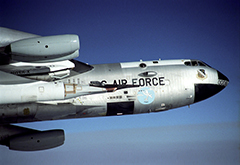NASA X-43 Aircraft
The X-43 was an experimental unmanned hypersonic aircraft with multiple planned scale variations meant to test various aspects of hypersonic flight. It was part of the X-plane series and specifically of NASA's Hyper-X program. It set several airspeed records for jet aircraft. The X-43 is the fastest aircraft on record at approximately Mach 9.6.
 A winged booster rocket with the X-43 placed on top, called a "stack", was drop launched from a Boeing B-52 Stratofortress. After the booster rocket (a modified first stage of the Pegasus rocket) brought the stack to the target speed and altitude, it was discarded, and the X-43 flew free using its own engine, a scramjet.
A winged booster rocket with the X-43 placed on top, called a "stack", was drop launched from a Boeing B-52 Stratofortress. After the booster rocket (a modified first stage of the Pegasus rocket) brought the stack to the target speed and altitude, it was discarded, and the X-43 flew free using its own engine, a scramjet.
The first plane in the series, the X-43A, was a single-use vehicle. Three of them were built. The first was destroyed after malfunctioning in flight; the other two flew successfully, with the scramjet operating for approximately 10 seconds, followed by a 10-minute glide and intentional crash into the ocean.
After the X-43 tests in 2004, NASA Dryden engineers said that they expected all of their efforts to culminate in the production of a two-stage-to-orbit crewed vehicle in about 20 years. The scientists expressed much doubt that there would be a Single-stage-to-orbit crewed vehicle like the National Aerospace Plane (NASP) in the foreseeable future.
Other X-43 vehicles were planned, but as of June 2013 they have been suspended or cancelled. They were expected to have the same basic body design as the X-43A, though the aircraft were expected to be moderately to significantly larger in size. More details
 A winged booster rocket with the X-43 placed on top, called a "stack", was drop launched from a Boeing B-52 Stratofortress. After the booster rocket (a modified first stage of the Pegasus rocket) brought the stack to the target speed and altitude, it was discarded, and the X-43 flew free using its own engine, a scramjet.
A winged booster rocket with the X-43 placed on top, called a "stack", was drop launched from a Boeing B-52 Stratofortress. After the booster rocket (a modified first stage of the Pegasus rocket) brought the stack to the target speed and altitude, it was discarded, and the X-43 flew free using its own engine, a scramjet.The first plane in the series, the X-43A, was a single-use vehicle. Three of them were built. The first was destroyed after malfunctioning in flight; the other two flew successfully, with the scramjet operating for approximately 10 seconds, followed by a 10-minute glide and intentional crash into the ocean.
After the X-43 tests in 2004, NASA Dryden engineers said that they expected all of their efforts to culminate in the production of a two-stage-to-orbit crewed vehicle in about 20 years. The scientists expressed much doubt that there would be a Single-stage-to-orbit crewed vehicle like the National Aerospace Plane (NASP) in the foreseeable future.
Other X-43 vehicles were planned, but as of June 2013 they have been suspended or cancelled. They were expected to have the same basic body design as the X-43A, though the aircraft were expected to be moderately to significantly larger in size. More details
